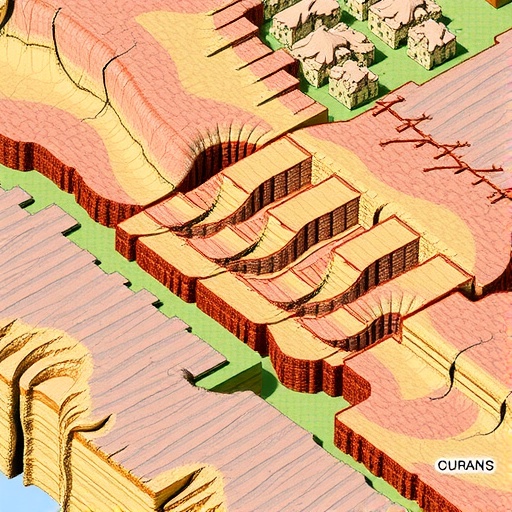In recent years, advancements in artificial intelligence and deep learning have significantly revolutionized various fields, from natural language processing to image recognition. Among these advancements, the application of deep learning techniques to geosciences is emerging as a groundbreaking approach, offering novel solutions to complex problems. A compelling illustration of this potential is highlighted in a recent study by Bahrami, Hassani, and Maghsoudi, which focuses on lithological mapping—an essential aspect of geological exploration—leveraging sophisticated convolutional neural networks (CNNs) optimized through hyper-parameter tuning.
Lithological mapping refers to the classification and description of rock types based on their physical characteristics, an activity that is vital for understanding geological formations and resource distribution. This study introduces a technique that utilizes HHO-optimized deep ResNet-18 and GoogleNet CNN models to achieve high precision in lithological mapping. This innovative approach combines the benefits of advanced deep learning architectures with optimization algorithms intended to enhance performance in data analysis tasks pertinent to lithological surveys.
The study’s authors clarify that traditional methods of lithological mapping, relying on manual interpretation and basic remote sensing imagery, often yield limited accuracy and effectiveness in diverse geographical contexts. As a response to these shortcomings, the authors adopted an alternative approach by integrating deep learning models specifically tailored for image recognition tasks. Their research aims to demonstrate that utilizing CNNs can significantly enhance the quality of lithological maps, potentially leading to improved decision-making in resource management and exploration.
To facilitate their research, the authors meticulously constructed a dataset rich in multispectral images representing various lithological types. They implemented rigorous training procedures for both the ResNet-18 and GoogleNet architectures, emphasizing the models’ capability to learn complex patterns within the data. Each model was subjected to a comprehensive optimization process driven by the HHO (Habitat Harmonic Optimization) algorithm, aimed at fine-tuning hyperparameters to ensure optimal performance.
The results from this study were particularly encouraging. The CNN models demonstrated remarkable accuracy rates in classifying and mapping different lithological units from the provided data. With the implementation of HHO, the researchers achieved enhancements in training efficiency and model robustness. These findings highlight not only the efficacy of CNNs but also the potential of optimization algorithms, which can play a crucial role in refining machine learning tasks across various applications.
Furthermore, the study’s implications extend to broader geological contexts, where precise lithological mapping contributes to understanding geological hazards and resource management. For instance, in areas prone to landslides or earthquakes, accurate lithological insights can help in risk assessment and mitigation strategies. Additionally, enhanced mapping can support the exploration of mineral resources, strengthening supply chains in industries reliant on geological materials.
While the study presents a step forward in applying AI methodologies to the geosciences, it also opens discussions regarding the long-term sustainability of such technologies. As the domain of machine learning evolves, it is crucial to consider how ethical implications and environmental effects integrate with technological advances. The research promotes a pathway for employing AI responsibly, urging further exploration into the intersection of technology and nature conservation.
In conclusion, Bahrami, Hassani, and Maghsoudi’s research stands at the forefront of merging deep learning technologies with geological sciences. Their approach not only paves the way for innovative methodologies in lithological mapping but also sets a precedent for future studies aimed at optimizing AI models for more extensive practical applications. This exciting development underscores the ongoing transformation within scientific disciplines, driven by the relentless progression of technology and its potential to reshape our understanding of the natural world.
As the field continues to evolve, the potential for lower costs and increased accuracy in geological assessments may soon become the norm rather than the exception. The studies such as this not only enlighten the conversation around AI in science but also inspire interdisciplinary collaborations that leverage technological advancements for practical, real-world applications. The call for further research and development in this area exists, as the implications for environmental science and resource management are vast. The future of lithological mapping looks promising with these innovative AI solutions paving the way for a more enlightened approach to understanding our planet’s geological complexities.
The ultimate goal is clear: utilize advanced technologies to enhance our capabilities, broaden our understanding, and foster solutions that are both innovative and socially responsible. Researchers and practitioners alike should embrace this paradigm shift, recognizing the significant role that optimized deep learning models will play in shaping the next era of geoscientific research.
Subject of Research:
Deep Learning Applications in Lithological Mapping
Article Title:
Precise Lithological Mapping Using HHO-Optimized Deep ResNet-18 and GoogleNet CNN Models
Article References:
Bahrami, Y., Hassani, H. & Maghsoudi, A. Precise Lithological Mapping Using HHO-Optimized Deep ResNet-18 and GoogleNet CNN Models.
Nat Resour Res 34, 2467–2507 (2025). https://doi.org/10.1007/s11053-025-10520-y
Image Credits:
AI Generated
DOI:
https://doi.org/10.1007/s11053-025-10520-y
Keywords:
Deep Learning, Lithological Mapping, Convolutional Neural Networks, Optimization Algorithms, Geosciences, Resource Management, HHO Optimization, Image Recognition




